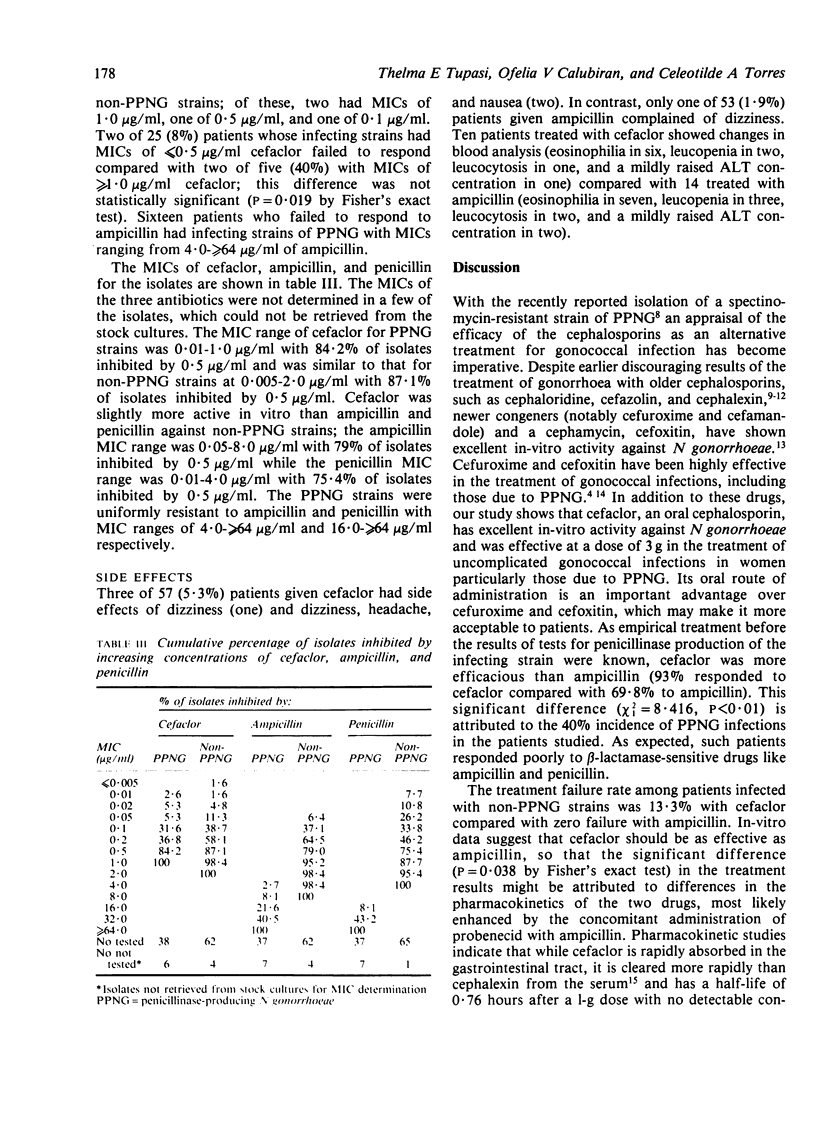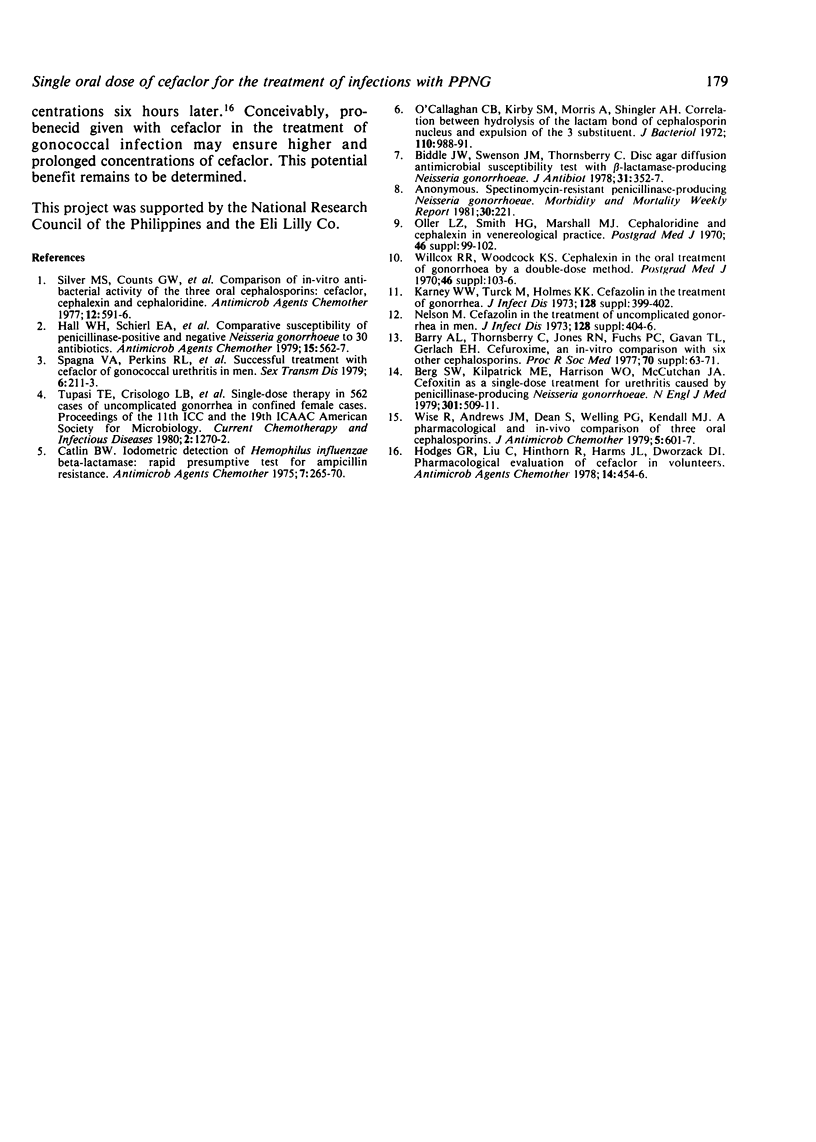Abstract
A single oral dose of 3 g cefaclor was effective in the treatment of uncomplicated gonococcal infection in women due to penicillinase-producing strains of Neisseria gonorrhoeae (PPNG). Cefaclor was equally active in vitro against both PPNG (MIC range, 0.01-1.0 microgram/ml) and non-PPNG strains (MIC range, 0.005-2.0 micrograms/ml). As empirical treatment cefaclor was effective in 53 of 57 (93%) patients compared with ampicillin, to which only 37 of 53 (69.8%) patients responded. This difference was attributed to the 40% incidence of PPNG in the patients studied; as expected, such patients responded poorly to ampicillin.
Full text
PDF



Selected References
These references are in PubMed. This may not be the complete list of references from this article.
- Barry A. L., Thornsberry C., Jones R. N., Fuchs P. C., Gavan T. L., Gerlach E. H. Cefuroxime, an in vitro Comparison with Six Other Cephalosporins. Proc R Soc Med. 1977;70(Suppl 9):63–71. doi: 10.1177/00359157770700S912. [DOI] [PMC free article] [PubMed] [Google Scholar]
- Berg S. W., Kilpatrick M. E., Harrison W. O., McCutchan J. A. Cefoxitin as a single-dose treatment for urethritis caused by penicillinase-producing Neisseria gonorrhoeae. N Engl J Med. 1979 Sep 6;301(10):509–511. doi: 10.1056/NEJM197909063011001. [DOI] [PubMed] [Google Scholar]
- Biddle J. W., Swenson J. M., Thornsberry C. Disc agar diffusion antimicrobial susceptibility tests with beta-lactamase producing Neisseria gonorrhoeae. J Antibiot (Tokyo) 1978 Apr;31(4):352–358. doi: 10.7164/antibiotics.31.352. [DOI] [PubMed] [Google Scholar]
- Catlin B. W. Iodometric detection of Haemophilus influenzae beta-lactamase: rapid presumptive test for ampicillin resistance. Antimicrob Agents Chemother. 1975 Mar;7(3):265–270. doi: 10.1128/aac.7.3.265. [DOI] [PMC free article] [PubMed] [Google Scholar]
- Hall W. H., Schierl E. A., Maccani J. E. Comparative susceptibility of penicillinase-positive and -negative Neisseria gonorrhoeae to 30 antibiotics. Antimicrob Agents Chemother. 1979 Apr;15(4):562–567. doi: 10.1128/aac.15.4.562. [DOI] [PMC free article] [PubMed] [Google Scholar]
- Hodges G. R., Liu C., Hinthorn D. R., Harms J. L., Dworzack D. L. Pharmacological evaluation of cefaclor in volunteers. Antimicrob Agents Chemother. 1978 Sep;14(3):454–456. doi: 10.1128/aac.14.3.454. [DOI] [PMC free article] [PubMed] [Google Scholar]
- O'Callaghan C. H., Kirby S. M., Morris A., Waller R. E., Duncombe R. E. Correlation between hydrolysis of the -lactam bond of the cephalosporin nucleus and expulsion of the 3-substituent. J Bacteriol. 1972 Jun;110(3):988–991. doi: 10.1128/jb.110.3.988-991.1972. [DOI] [PMC free article] [PubMed] [Google Scholar]
- Oller L. Z., Smith H. G., Marshall M. J. Cephaloridine and cephalexin in venereological practice. Postgrad Med J. 1970 Oct;(Suppl):99–102. [PubMed] [Google Scholar]
- Silver M. S., Counts G. W., Zeleznik D., Turck M. Comparison of in vitro antibacterial activity of three oral cephalosporins: cefaclor, cephalexin, and cephradine. Antimicrob Agents Chemother. 1977 Nov;12(5):591–596. doi: 10.1128/aac.12.5.591. [DOI] [PMC free article] [PubMed] [Google Scholar]
- Spagna V. A., Perkins R. L., Prior R. B. Successful treatment with cefaclor of gonococcal urethritis in men. Sex Transm Dis. 1979 Jul-Sep;6(3):211–213. doi: 10.1097/00007435-197907000-00005. [DOI] [PubMed] [Google Scholar]
- Willcox R. R., Woodcock K. S. Cephalexin in the oral treatment of gonorrhoea by a double-dose method. Postgrad Med J. 1970 Oct;(Suppl):103–106. [PubMed] [Google Scholar]
- Wise R., Andrews J. M., Dean S., Welling P. G., Kendall M. J. A pharmacological and in vitro comparison of three oral cephalosporins. J Antimicrob Chemother. 1979 Sep;5(5):601–607. doi: 10.1093/jac/5.5.601. [DOI] [PubMed] [Google Scholar]


